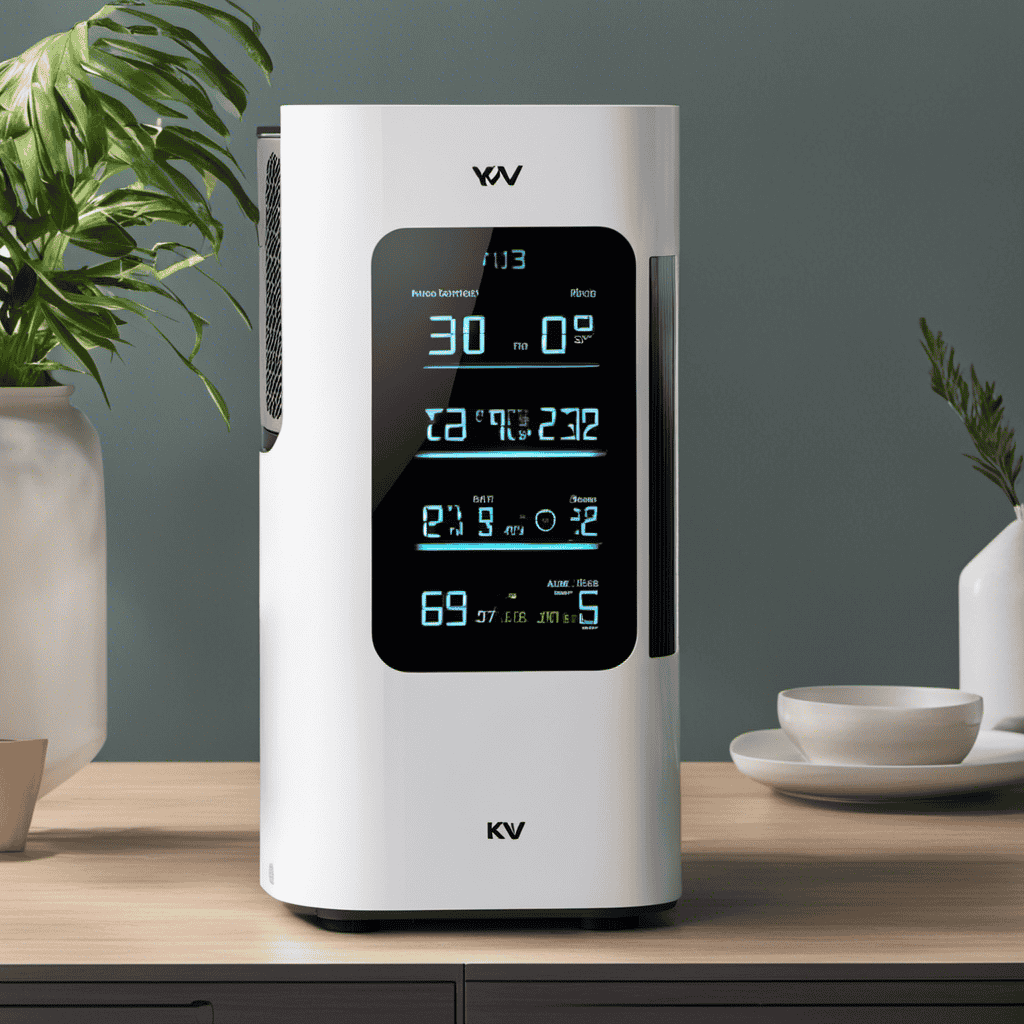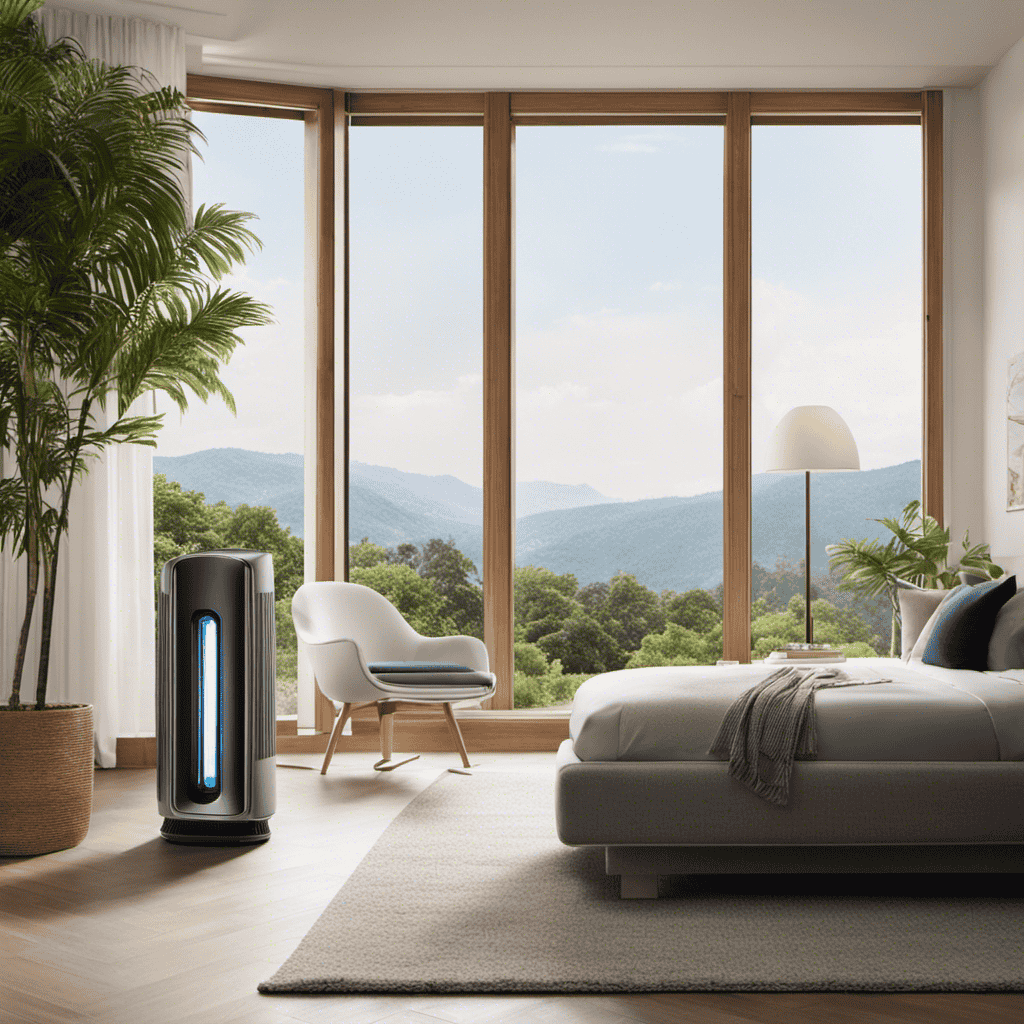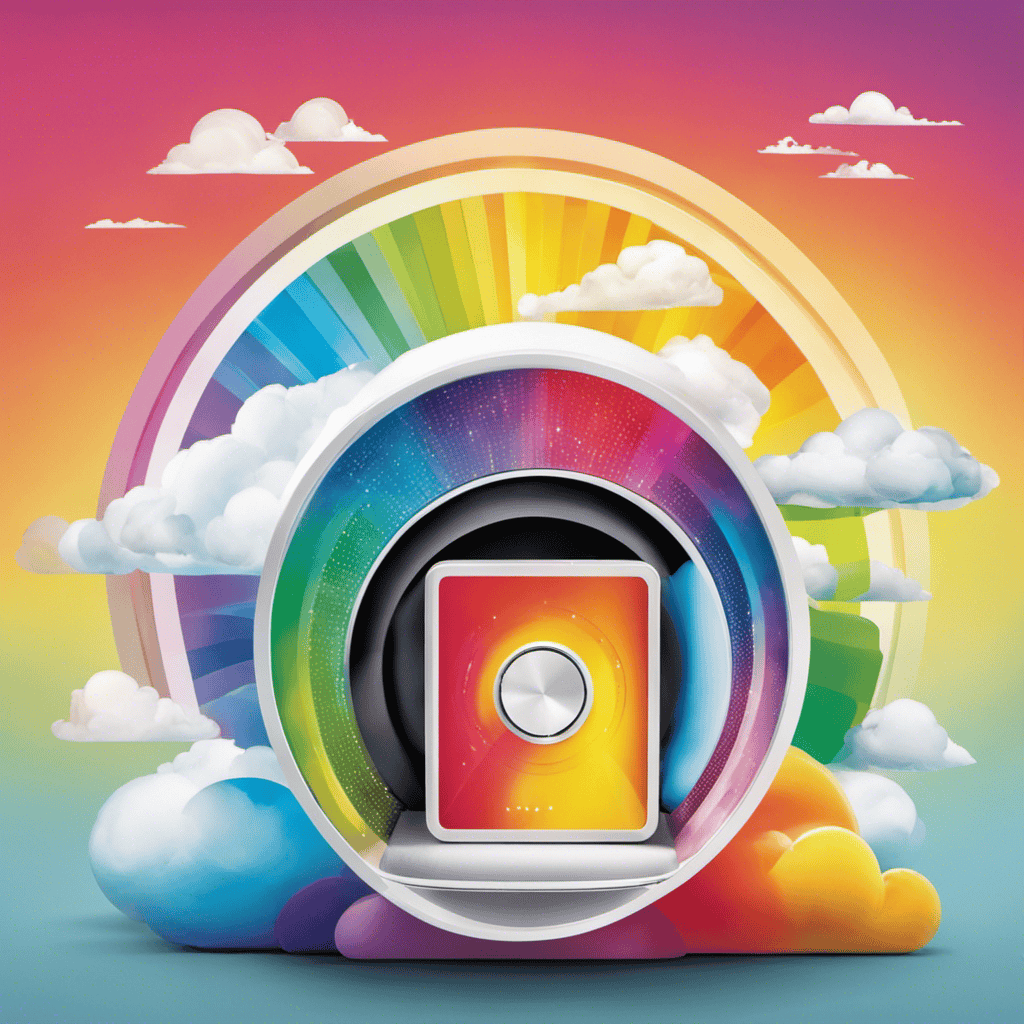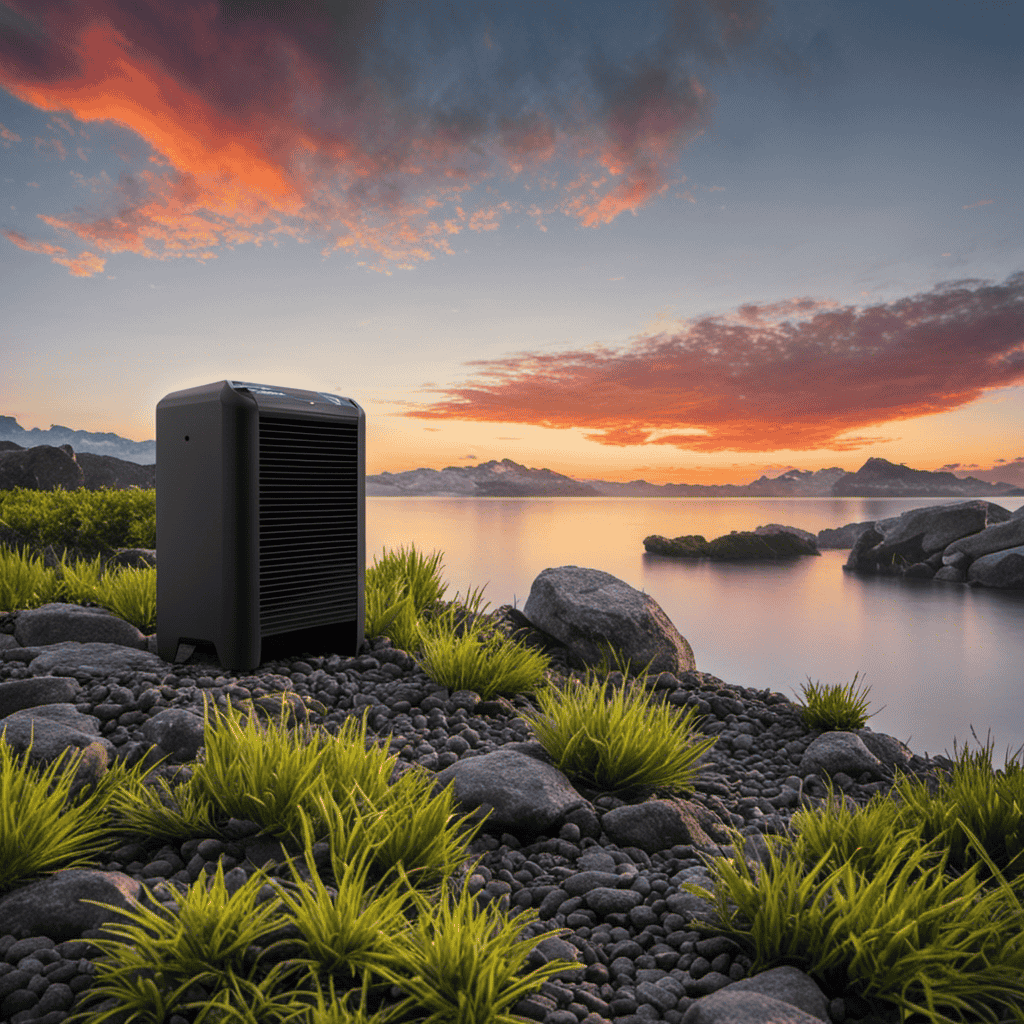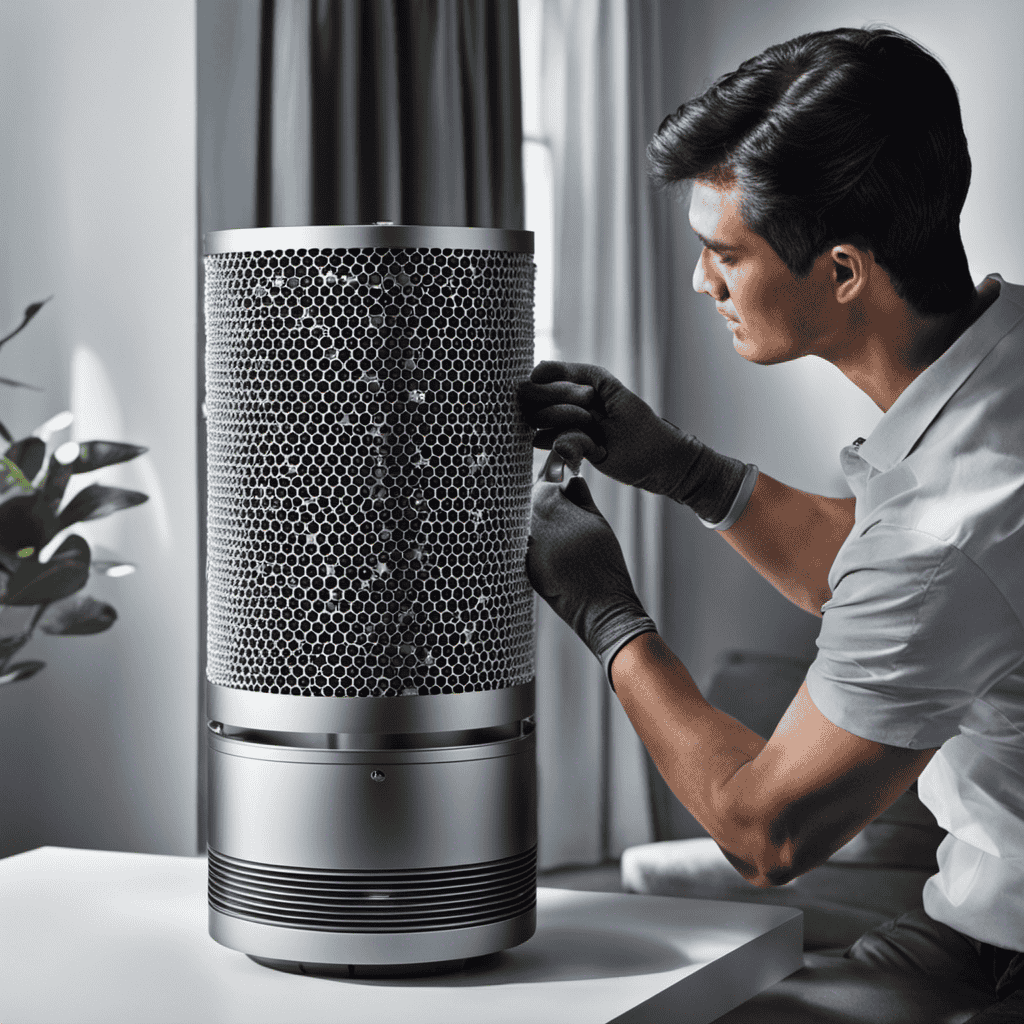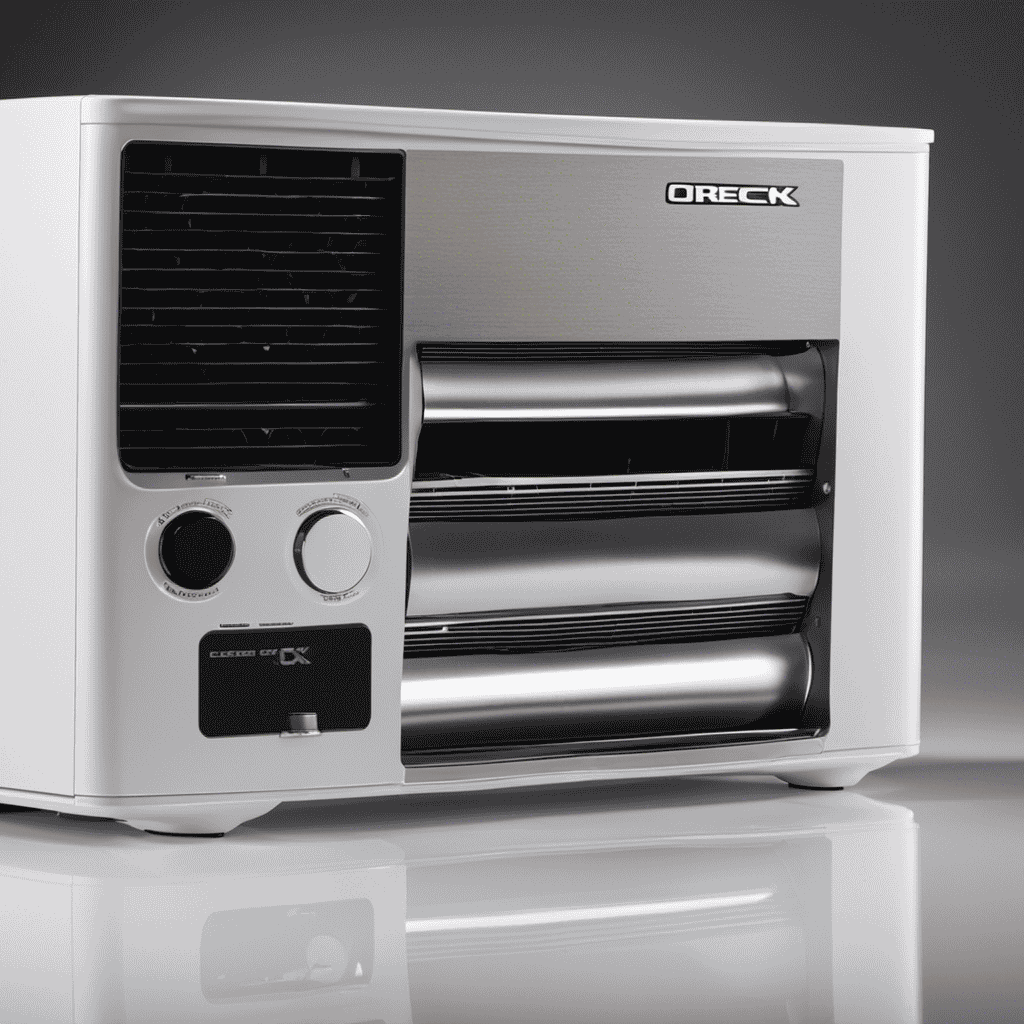Have you ever been curious about the significance of the numbers displayed on your Kvv air purifier?
In this article, I will break down the technical aspects of these numbers and help you understand their significance.
From the Air Quality Index (AQI) to the PM2.5 measurement, VOC levels, humidity readings, and even carbon dioxide (CO2) levels, we will decipher it all.
Additionally, we will analyze the fan speed indicator, filter replacement indicator, and power consumption data.
Get ready to compare air purifier models like a pro based on the numbers!
Key Takeaways
- The KVV air purifier displays the level of PM2.5 in the air, which is important for monitoring and improving air quality.
- Monitoring VOC levels on the KVV air purifier allows us to take necessary actions to improve indoor air quality and prevent health issues.
- Maintaining a balanced humidity level is crucial for promoting comfort and preventing issues like mold growth and dry skin.
- Monitoring and controlling CO2 levels is important for maintaining a healthy indoor environment and preventing potential health risks.
Understanding the Air Quality Index (AQI
To understand the Air Quality Index (AQI), you’ll need to know what the numbers mean. The AQI is a tool used to measure and report air quality in a specific area. It provides information about the level of air pollution and its potential impacts on human health.
The numbers on the AQI scale range from 0 to 500, with higher numbers indicating worse air quality. The AQI takes into account various pollutants such as particulate matter, ozone, carbon monoxide, sulfur dioxide, and nitrogen dioxide. These pollutants are known to be harmful to human health and can cause respiratory problems, cardiovascular diseases, and even premature death.
Air quality monitoring is crucial to identify air pollution causes and take appropriate measures to reduce emissions and protect public health.
Decoding the PM2.5 Measurement
The numbers on the KVV air purifier display indicate the level of PM2.5 in the air. PM2.5 refers to particles with a diameter of 2.5 micrometers or smaller. These tiny particles can come from various sources, including:
- Industrial emissions: Factories and power plants release pollutants into the air, contributing to PM2.5 levels.
- Vehicle exhaust: Cars, trucks, and other vehicles emit pollutants that can become PM2.5 particles.
- Agricultural activities: Dust and smoke from farming practices can also contribute to PM2.5 levels.
- Residential combustion: Burning wood, coal, or other fuels for heating or cooking can release PM2.5 particles.
- Natural sources: Forest fires, dust storms, and volcanic eruptions can introduce PM2.5 particles into the air.
Exposure to high levels of PM2.5 can have detrimental health effects, including respiratory issues, cardiovascular problems, and increased risk of lung cancer. It’s essential to monitor and reduce PM2.5 levels to protect our health and well-being.
Interpreting the VOC Levels
When it comes to air quality, understanding the significance of VOC levels is crucial. VOCs, or volatile organic compounds, are chemicals that can easily vaporize into the air and have the potential to cause various health issues.
High levels of VOCs can lead to respiratory problems, eye and throat irritation, and even long-term health effects such as cancer. Therefore, it is essential to delve into the details of VOC levels and their implications for our well-being.
VOC Level Significance
There’s a VOC level on the kvv air purifier that indicates the significance of the air quality. This level is determined by measuring the concentration of volatile organic compounds (VOCs) in the air. VOCs are emitted by various sources and can have negative effects on our health. Understanding the significance of the VOC level is crucial for maintaining a clean and healthy indoor environment.
Here are some key points to consider:
-
VOC Level Sources: VOCs can come from a variety of sources including cleaning products, paints, furniture, and even personal care products.
-
Health Implications: High VOC levels can lead to respiratory issues, allergies, and even long-term health problems.
-
Air Quality Control: Monitoring the VOC level allows us to take necessary actions to improve indoor air quality, such as using proper ventilation or reducing the use of VOC-emitting products.
-
Impact on Daily Life: VOC levels can vary throughout the day and can be influenced by activities like cooking or cleaning.
-
Long-term Benefits: Maintaining a low VOC level in our indoor environment can lead to improved health, better sleep, and overall well-being.
Health Implications of Vocs
Understanding the health implications of VOCs is crucial for maintaining a clean and healthy indoor environment. VOCs, or volatile organic compounds, are chemicals that can be found in various household products and materials such as paints, cleaning agents, and furniture. These compounds can easily evaporate into the air, leading to potential health risks when inhaled. Exposure to high levels of VOCs can cause a range of symptoms including eye, nose, and throat irritation, headaches, dizziness, and even long-term effects on the respiratory and nervous systems. To help you better understand the potential health risks associated with VOC exposure, here is a table highlighting some common VOC sources and their potential effects on indoor air quality:
| VOC Source | Potential Health Effects |
|---|---|
| Paints | Eye and respiratory irritation |
| Cleaning Agents | Headaches and dizziness |
| Furniture | Allergic reactions and respiratory problems |
Analyzing the Humidity Readings
You can easily identify the humidity level by looking at the numbers on the kvv air purifier. The humidity readings provide valuable information about the moisture levels in your environment, allowing you to take necessary actions to maintain a comfortable and healthy space.
Here’s what the numbers on the kvv air purifier mean:
-
Optimal Humidity Range: The ideal humidity level for most indoor spaces is between 30% to 50%. This range ensures a balanced moisture level that promotes comfort and prevents issues like dry skin or mold growth.
-
High Humidity Alert: If the number on the purifier exceeds 50%, it indicates high humidity levels. This can lead to condensation, musty odors, and the growth of mold or mildew.
-
Low Humidity Alert: When the number drops below 30%, it signifies low humidity levels. This can cause dryness, discomfort, and may exacerbate respiratory conditions.
Evaluating the Carbon Dioxide (CO2) Levels
When it comes to evaluating the carbon dioxide (CO2) levels in our environment, it is crucial to understand the health implications associated with high concentrations of this gas.
Excessive CO2 levels can lead to a range of health issues such as headaches, dizziness, and difficulty concentrating.
Therefore, it is important to determine the optimal CO2 levels to maintain a healthy indoor environment and prevent any potential health risks.
CO2 Health Implications
The CO2 levels in your environment can have negative health effects. It is important to monitor and control the levels to ensure a healthy indoor environment.
Here are some key effects of high CO2 levels on health:
-
Reduced cognitive function: High CO2 levels can impair cognitive function, affecting decision-making, attention, and memory.
-
Headaches and dizziness: Increased CO2 concentration can cause headaches, dizziness, and general discomfort.
-
Respiratory issues: Prolonged exposure to high CO2 levels can lead to respiratory problems such as shortness of breath and wheezing.
-
Fatigue and tiredness: Elevated CO2 concentrations can cause fatigue, making individuals feel tired and less productive.
-
Increased heart rate: Higher CO2 levels can lead to an increased heart rate, putting strain on the cardiovascular system.
Monitoring CO2 levels is crucial in maintaining a healthy indoor environment. Using CO2 monitors can help identify areas with high concentrations and implement necessary measures to reduce CO2 levels, ensuring the well-being of occupants.
Optimal CO2 Levels
To maintain a healthy indoor environment, it’s important to ensure that CO2 levels are within the optimal range. Optimal CO2 levels refer to the ideal concentration of carbon dioxide in the air for human comfort and well-being.
Indoor air quality standards provide guidelines for maintaining these levels. The recommended range for CO2 concentration is typically between 400 to 1,000 parts per million (ppm). Levels below 400 ppm are considered excellent, while levels above 1,000 ppm may indicate poor ventilation or high occupancy.
Monitoring and controlling CO2 levels is crucial because elevated concentrations can lead to symptoms like headaches, dizziness, and fatigue. Additionally, high CO2 levels can indicate the presence of other indoor air pollutants.
Regularly checking and maintaining optimal CO2 levels is vital for ensuring a healthy and comfortable indoor environment.
Unraveling the Noise Level Data
Unraveling the noise level data can help users determine the most suitable operating mode for their kvv air purifier. Measuring sound levels is crucial in understanding the impact of noise pollution on our environment. Here are five key points to consider when analyzing noise level data:
- Sound level measurements are typically expressed in decibels (dB), which is a logarithmic scale that quantifies the intensity of sound.
- The World Health Organization (WHO) recommends a maximum noise level of 50 dB during the daytime for indoor environments.
- Noise levels above 70 dB can be harmful to human health and may cause sleep disturbances, stress, and other adverse effects.
- Different operating modes of the kvv air purifier may produce varying noise levels, allowing users to choose the mode that meets their noise tolerance.
- Regular monitoring of noise levels can help identify areas with high noise pollution, enabling targeted interventions to improve overall air quality and reduce noise-related health risks.
Interpreting the Temperature Readings
Interpreting temperature readings can provide valuable insights into the effectiveness of the air purifier’s cooling capabilities. By analyzing temperature variations and trends, we can better understand how well the air purifier is performing in maintaining a comfortable and consistent temperature in the room. To assist you in interpreting the temperature readings, I have provided a table below:
| Time | Temperature (°C) |
|---|---|
| 9:00 AM | 25.8 |
| 10:00 AM | 26.3 |
| 11:00 AM | 26.9 |
| 12:00 PM | 27.5 |
| 1:00 PM | 28.0 |
From this table, we can observe a gradual increase in temperature throughout the morning, indicating that the air purifier might be struggling to cool the room effectively. Analyzing temperature trends over time can help us identify any issues with the air purifier’s cooling capabilities and take appropriate measures to address them.
Deciphering the Fan Speed Indicator
Now that we have covered how to interpret the temperature readings on the KVV air purifier, let’s move on to deciphering the fan speed indicator. Understanding the fan speed is crucial for optimizing the performance of your air purifier.
Here’s an explanation of the fan speed indicator:
- The fan speed indicator on the KVV air purifier displays a numerical value ranging from 1 to 5.
- A higher number indicates a higher fan speed, which means that the air purifier is working at a faster rate to clean the air in your space.
- The fan speed directly affects the airflow and the efficiency of pollutant removal.
- Increasing the fan speed can help improve the air purifier’s performance in larger rooms or areas with high levels of pollution.
- Adjusting the fan speed to a lower setting can help conserve energy and reduce noise levels.
Understanding the fan speed indicator will allow you to optimize the performance of your KVV air purifier based on your specific needs and the air quality of your surroundings.
Understanding the Filter Replacement Indicator
The filter replacement indicator on the KVV air purifier lets you know when it’s time to replace the filter.
Understanding the filter lifespan is crucial for maintaining the efficiency and effectiveness of the air purifier. The filter lifespan can vary depending on factors such as usage frequency, air quality, and the type of filter being used.
Timely filter replacement is essential as it ensures that the air purifier continues to remove pollutants and allergens from the air effectively. Neglecting to replace the filter can result in reduced air quality and decreased performance of the purifier.
By replacing the filter on time, you can ensure that the air in your space remains clean and healthy.
Now, let’s move on to analyzing the power consumption data to further optimize the usage of your KVV air purifier.
Analyzing the Power Consumption Data
When analyzing the power consumption data of various appliances, it’s important to consider energy usage patterns, efficiency comparisons, and the impact on electricity bills.
By examining energy usage patterns, we can identify peak times of consumption and make informed decisions on when to use certain appliances.
Efficiency comparisons allow us to evaluate the effectiveness of different appliances and determine which ones are more energy-efficient.
Lastly, understanding the impact on electricity bills helps us manage our energy consumption and find ways to reduce costs.
Energy Usage Patterns
To understand the energy usage patterns of the KVV air purifier, it’s helpful to review the numbers and how they correspond to different modes of operation. The energy efficiency of the KVV air purifier is measured by the power consumption in different modes.
Here are the key points to consider:
-
Low mode: This mode consumes the least amount of energy, making it ideal for continuous use throughout the day.
-
Medium mode: This mode provides a balance between energy efficiency and air purification effectiveness, suitable for regular use in moderately polluted environments.
-
High mode: This mode consumes more energy but offers powerful air purification, making it ideal for use in highly polluted areas or during allergy seasons.
-
Sleep mode: This mode is optimized for nighttime use, reducing both noise and energy consumption while maintaining efficient air purification.
-
Auto mode: In this mode, the air purifier adjusts its fan speed and energy consumption based on the air quality, ensuring optimal performance while minimizing energy use.
Understanding these usage patterns will help you make informed decisions about the energy efficiency of the KVV air purifier and choose the appropriate mode for your needs.
Efficiency Comparisons
You can compare the efficiency of different modes by reviewing their power consumption and air purification effectiveness.
When analyzing the efficiency factors of an air purifier, it is crucial to consider its power consumption. This can be measured by examining the wattage consumed by the device in each mode.
Additionally, the air purification effectiveness is an essential aspect of performance analysis. It involves evaluating the unit’s ability to remove pollutants from the air, such as dust particles, allergens, and harmful gases.
By comparing the power consumption and air purification effectiveness of various modes, you can determine the most efficient option for your needs.
Understanding these efficiency factors will not only help you choose an effective air purifier, but it will also have a significant impact on your electricity bills.
Impact on Electricity Bills
Understanding the impact on your electricity bills is essential when comparing the efficiency of different air purifier modes. The electricity consumption of an air purifier depends on various factors, such as the fan speed, duration of usage, and power settings. Here are some energy-saving tips to consider:
- Adjust the fan speed to a lower setting: Lower fan speeds consume less energy.
- Use the timer function: Set the air purifier to run only when needed, reducing unnecessary electricity usage.
- Clean or replace filters regularly: Clogged filters can make the air purifier work harder, consuming more energy.
- Consider purchasing an air purifier with an Energy Star rating: These models are designed to be more energy-efficient.
- Keep the air purifier in a properly sized room: Using a larger air purifier in a smaller room can waste energy.
Comparing the Air Purifier Models Based on Numbers
Comparing the air purifier models based on numbers can help determine which one is the most effective. When interpreting the air purifier specifications, it is important to evaluate the performance metrics.
These metrics provide detailed information about the effectiveness of the air purifier in removing pollutants from the air. One important specification to consider is the Clean Air Delivery Rate (CADR), which measures the volume of clean air that the purifier can deliver per minute. A higher CADR indicates a more efficient air purifier.
Another important metric is the Air Changes per Hour (ACH), which measures how many times the air in a room is completely filtered per hour. A higher ACH value indicates a more thorough purification process.
Additionally, it is crucial to consider the filter efficiency, noise level, and energy consumption when comparing air purifier models.
Frequently Asked Questions
How Does the Kvv Air Purifier Compare to Other Air Purifiers on the Market in Terms of Noise Level?
In terms of noise level, the Kvv Air Purifier performs comparably to other purifiers on the market. The noise level of the Kvv Air Purifier is similar to that of other models in its category.
Can the Kvv Air Purifier Be Used in Large Rooms or Is It Only Suitable for Small Spaces?
The Kvv air purifier is suitable for large rooms and even commercial spaces. Its powerful filtration system and high air flow rate ensure efficient purification in larger areas, making it a versatile choice for different environments.
Is There a Specific Range of Temperature That the Kvv Air Purifier Is Designed to Work Optimally In?
The optimal temperature range for the Kvv Air Purifier is 65-85 degrees Fahrenheit. Performance may vary in different temperature ranges. Remember, as the old saying goes, "The right temperature ensures the best air purification."
Are There Any Additional Filters or Accessories That Need to Be Purchased Separately for the Kvv Air Purifier?
Yes, additional filters are necessary for the Kvv air purifier to ensure optimal performance. Recommended accessories to enhance its performance include a pre-filter, activated carbon filter, and a HEPA filter.
How Long Does the Kvv Air Purifier Typically Last Before Needing to Be Replaced or Serviced?
The lifespan of the Kvv Air Purifier varies depending on usage and maintenance. It typically lasts 3-5 years before needing replacement or servicing. Common issues with the Kvv Air Purifier include filter clogging and motor malfunction.
Conclusion
In conclusion, understanding the numbers on the KVv air purifier is essential for evaluating its performance and effectiveness.
One interesting statistic to highlight is the PM2.5 measurement, which indicates the level of fine particulate matter in the air. This number is crucial because PM2.5 particles can be harmful to our health, especially for those with respiratory conditions.
By analyzing the PM2.5 levels, we can ensure that our air purifier is effectively filtering out these harmful particles, providing us with clean and healthy indoor air.
